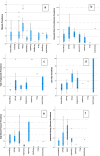Cardiometabolic risk factors in South American children: A systematic review and meta-analysis
- PMID: 37992076
- PMCID: PMC10664905
- DOI: 10.1371/journal.pone.0293865
Cardiometabolic risk factors in South American children: A systematic review and meta-analysis
Abstract
Background: Cardiometabolic risk factors (impaired fasting glucose, abdominal obesity, high blood pressure, dyslipidemia) cluster in children, may predict adult disease burden, and are inadequately characterized in South American children.
Objectives: To quantify the burden of cardiometabolic risk factors in South American children (0-21 years) and identify knowledge gaps.
Methods: We systematically searched PubMed, Google Scholar, and the Latin American and Caribbean Health Sciences Literature via Virtual Health Library from 2000-2021 in any language. Two independent reviewers screened and extracted all data.
Results: 179 studies of 2,181 screened were included representing 10 countries (n = 2,975,261). 12.2% of South American children experienced obesity, 21.9% elevated waist circumference, 3.0% elevated fasting glucose, 18.1% high triglycerides, 29.6% low HDL cholesterol, and 8.6% high blood pressure. Cardiometabolic risk factor definitions varied widely. Chile exhibited the highest prevalence of obesity/overweight, low HDL, and impaired fasting glucose. Ecuador exhibited the highest prevalence of elevated blood pressure. Rural setting (vs. urban or mixed) and indigenous origin protected against most cardiometabolic risk factors.
Conclusions: South American children experience high rates of obesity, overweight, and dyslipidemia. International consensus on cardiometabolic risk factor definitions for children will lead to improved diagnosis of cardiometabolic risk factors in this population, and future research should ensure inclusion of unreported countries and increased representation of indigenous populations.
Copyright: © 2023 Singleton et al. This is an open access article distributed under the terms of the Creative Commons Attribution License, which permits unrestricted use, distribution, and reproduction in any medium, provided the original author and source are credited.
Conflict of interest statement
The authors declare that no competing interests exist.
Figures


References
-
- Alberti GKMM, Zimmet P, Shaw JE, Grundy SM. The IDF consensus worldwide definition of the metabolic syndrome. IDF Task Force on Epidemiology and Prevention. 2006.
-
- Zimmet P, Alberti GKMM, Kaufman F, Tajima N, Silink M, Arslanian S, et al. The metabolic syndrome in children and adolescents—An IDF consensus report. Pediatric Diabetes. John Wiley & Sons, Ltd; 2007; 8:299–306. - PubMed
Publication types
MeSH terms
Substances
LinkOut - more resources
Full Text Sources
Medical

